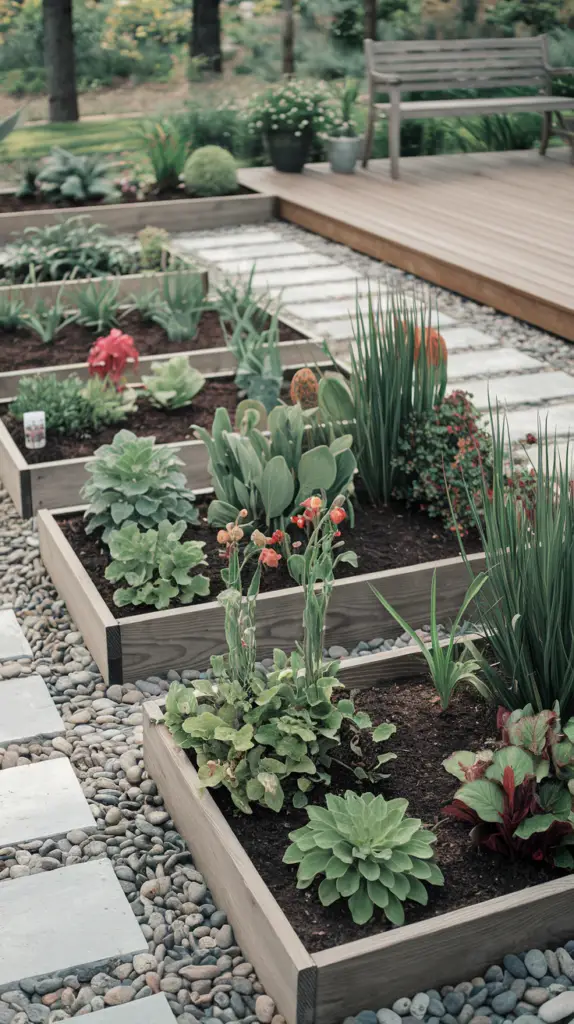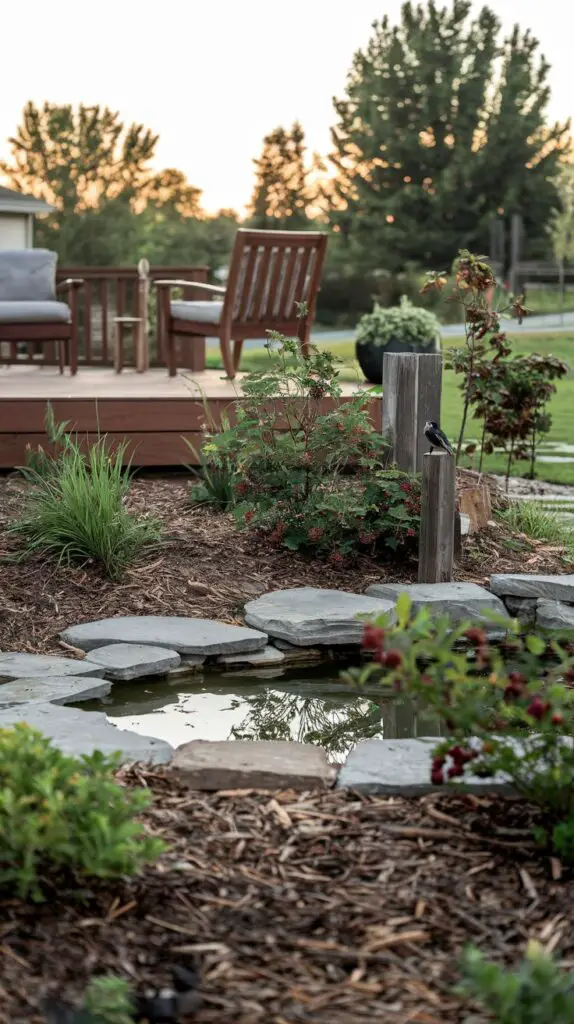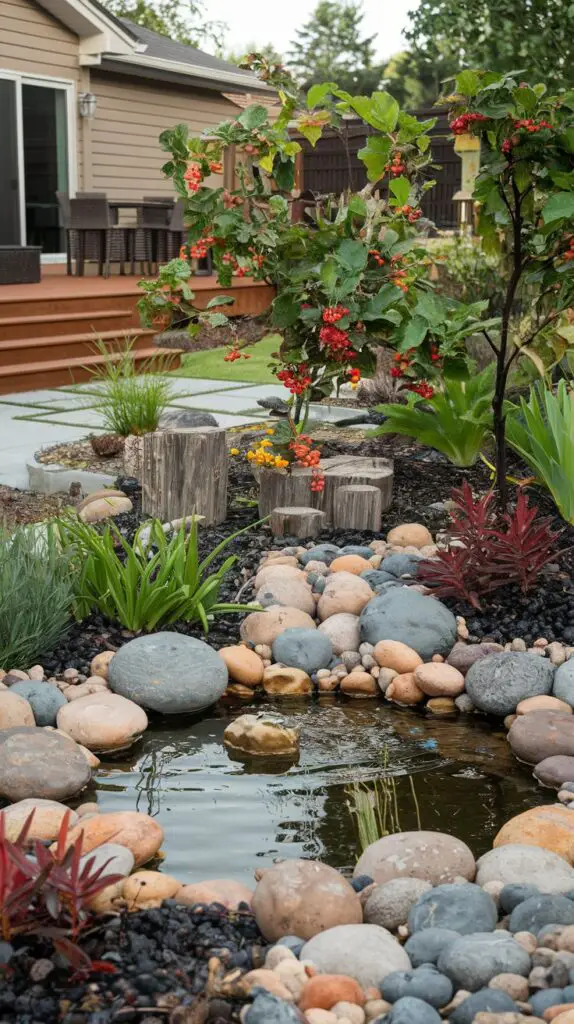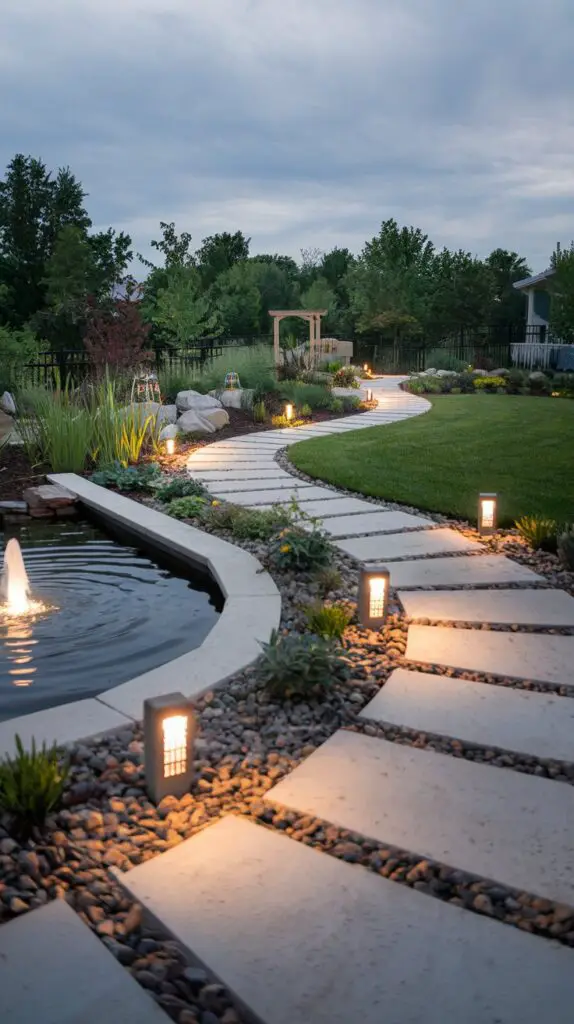Transforming your backyard into an eco-friendly oasis isn’t just great for the planet—it can also save you money, create a beautiful space for relaxation, and provide a haven for local wildlife.
In this article, we’ll explore nine sustainable landscaping ideas that are both practical and innovative. Whether you’re a seasoned gardener or new to sustainable living, these tips will help you create a backyard that’s as kind to the Earth as it is stunning. Let’s dig in!
Eco-Friendly Backyard Landscaping: 9 Sustainable Ideas to Try
1. Native Plant Gardens
Native plants are the cornerstone of eco-friendly backyard landscaping. These plants are naturally adapted to the local climate, requiring less water, fertilizer, and maintenance than exotic species. By incorporating native plants into your garden, you can create a lush and thriving environment that supports local wildlife such as birds, bees, and butterflies. Begin by researching plants that are indigenous to your region, focusing on those that offer aesthetic appeal while being hardy and resilient.
Native plant gardens help in restoring the natural ecosystem. They provide food and shelter to pollinators and other beneficial insects, which are essential for maintaining biodiversity. Additionally, native plants often have deep root systems that help reduce soil erosion and improve water infiltration. This not only conserves water but also helps replenish groundwater levels, making it a sustainable choice for the environment.
To design a native plant garden, consider layering plants of different heights and textures to mimic natural habitats. Group plants with similar water and light needs together to make maintenance easier. Use organic mulch to suppress weeds and retain soil moisture, and avoid using pesticides or chemical fertilizers that can harm the ecosystem. Over time, your garden will become a self-sustaining haven of biodiversity.

2. Rain Gardens
Rain gardens are an innovative way to manage stormwater runoff while enhancing the beauty of your backyard. These shallow depressions are designed to capture and absorb rainwater, preventing it from flowing into storm drains and carrying pollutants into local waterways. Rain gardens are not only functional but also visually appealing, featuring a variety of plants that thrive in wet conditions.
To create a rain garden, identify a low-lying area in your yard where water naturally collects. Ensure the spot is at least 10 feet away from your home’s foundation to avoid water seepage issues. Choose native plants that can tolerate both wet and dry conditions, such as swamp milkweed, blue flag iris, and Joe-Pye weed. These plants will help filter pollutants and provide habitat for wildlife.
Incorporate gravel or sand into the soil to improve drainage and prevent waterlogging. Surround your rain garden with a border of stones or decorative edging to define its boundaries. Over time, your rain garden will not only reduce the strain on municipal stormwater systems but also create a vibrant focal point in your backyard.

3. Composting Stations
A composting station is a practical and sustainable addition to any backyard. By composting kitchen scraps and yard waste, you can reduce the amount of organic material sent to landfills while creating nutrient-rich soil for your garden. Composting is an excellent way to close the loop on organic waste, turning it into a valuable resource for your landscaping needs.
To set up a composting station, choose a shaded area in your yard that is easily accessible. You can purchase a ready-made compost bin or build your own using wooden pallets or wire mesh. Ensure the bin has proper ventilation and drainage to promote aerobic decomposition. Layer green materials, such as fruit and vegetable scraps, with brown materials like leaves and cardboard to maintain a balanced compost pile.
Turn the pile regularly to aerate it and speed up the decomposition process. In a few months, you’ll have dark, crumbly compost that can be used to enrich garden beds, improve soil structure, and reduce the need for chemical fertilizers. Composting not only benefits your garden but also contributes to a more sustainable waste management system.

4. Permeable Paving
Traditional paving materials like concrete and asphalt can create impermeable surfaces that contribute to water runoff and urban heat islands. Permeable paving offers a sustainable alternative by allowing water to seep through the surface and into the ground. This helps reduce flooding, replenish groundwater, and mitigate heat buildup in your backyard.
There are various options for permeable paving, including porous concrete, permeable pavers, and gravel. These materials can be used to create walkways, patios, and driveways that blend seamlessly with your landscaping. Permeable paving not only reduces environmental impact but also adds texture and visual interest to your outdoor space.
When installing permeable paving, ensure the underlying base is designed to support drainage. This typically involves layers of gravel and sand that help filter water as it infiltrates the ground. Combine permeable paving with native plants and rain gardens to create a cohesive and eco-friendly backyard design. Regular maintenance, such as sweeping and occasional re-leveling, will keep your permeable surfaces looking and functioning their best.

5. Vertical Gardens
Vertical gardens are a creative solution for small backyards or urban spaces where horizontal gardening is limited. By growing plants on walls or trellises, you can maximize space while creating a green and vibrant backdrop for your outdoor area. Vertical gardens are not only visually stunning but also contribute to improved air quality and insulation.
To start a vertical garden, choose a sunny wall or structure that can support the weight of plants and soil. You can use wall-mounted planters, pocket panels, or even repurposed items like pallets and gutters. Select plants that thrive in vertical setups, such as herbs, succulents, or climbing vines like jasmine and clematis. Incorporate a drip irrigation system to ensure consistent watering without wasting water.
Vertical gardens can also serve as functional features, such as privacy screens or noise barriers. They’re ideal for growing edible plants like strawberries, lettuce, and tomatoes, adding a sustainable and delicious element to your backyard. With proper care and attention, a vertical garden can transform a plain wall into a lush, living masterpiece.

6. Xeriscaping
Xeriscaping is a water-efficient landscaping method that focuses on reducing water usage while maintaining aesthetic appeal. This approach is especially beneficial in arid or drought-prone regions, where water conservation is a top priority. By incorporating drought-tolerant plants and efficient irrigation systems, xeriscaping can significantly lower your water bills and environmental impact.
Begin by designing your yard with zones based on water needs, placing the most drought-tolerant plants in areas that receive the most sun. Choose plants like lavender, yucca, and sedum that thrive in low-water conditions. Use mulch or gravel to retain soil moisture and reduce evaporation. Incorporate decorative elements like rocks and sculptures to add visual interest without relying solely on plants.
Efficient irrigation is a key component of xeriscaping. Drip irrigation systems deliver water directly to the roots, minimizing waste and ensuring plants receive adequate moisture. Rain barrels can also be integrated into your design to collect and reuse rainwater. With thoughtful planning, xeriscaping can create a stunning and sustainable backyard that thrives with minimal water input.

7. Wildlife Habitats
Creating a wildlife habitat in your backyard is a rewarding way to support biodiversity while enjoying the beauty of nature. By providing food, water, shelter, and nesting sites, you can attract a variety of birds, butterflies, and other creatures to your garden. Wildlife habitats are not only beneficial for the environment but also enhance the sensory experience of your outdoor space.
Start by planting a mix of native flowering plants, shrubs, and trees that offer nectar, seeds, and berries. Include water features like birdbaths or small ponds to provide drinking and bathing opportunities for wildlife. Add features such as log piles, rock shelters, or birdhouses to create safe spaces for animals to rest and nest.
Avoid using pesticides or herbicides, as these can harm the creatures you aim to attract. Instead, practice organic gardening techniques and encourage natural predators like ladybugs and birds to manage pests. Over time, your backyard will become a thriving sanctuary that supports local ecosystems and brings you closer to nature.

8. Edible Landscaping
Edible landscaping combines beauty and functionality by incorporating food-producing plants into your garden design. This sustainable approach reduces reliance on store-bought produce, promotes healthy eating, and minimizes the environmental impact of transporting food. With careful planning, edible landscaping can be both productive and visually appealing.
Integrate fruits, vegetables, and herbs into existing flower beds or create dedicated edible garden zones. Choose plants that complement each other aesthetically and functionally, such as pairing colorful chard with marigolds or planting strawberries as ground cover. Use trellises or arches to grow climbing crops like beans and cucumbers, adding vertical interest to your design.
To maintain an edible landscape, practice crop rotation and companion planting to deter pests and improve soil health. Incorporate organic compost and mulch to nourish your plants and retain moisture. By combining form and function, edible landscaping transforms your backyard into a bountiful and beautiful space.

9. Solar-Powered Features
Solar-powered features are an excellent way to enhance your backyard while reducing your carbon footprint. From lighting to water pumps, solar energy can power a variety of outdoor elements, making your backyard more sustainable and energy-efficient. These features not only save on electricity costs but also contribute to a greener environment.
Install solar-powered lights along pathways, garden beds, and patios to create a warm and inviting ambiance. Choose models with built-in sensors that automatically turn on at dusk and off at dawn. For water features like fountains or ponds, consider solar-powered pumps that operate without the need for electrical wiring.
Solar panels can also be integrated into pergolas or shade structures to generate power for other outdoor appliances. By harnessing the sun’s energy, you can enjoy a beautifully lit and functional backyard while minimizing your reliance on non-renewable energy sources. With a variety of solar-powered options available, it’s easy to find solutions that suit your style and sustainability goals.

Conclusion
Creating an eco-friendly backyard is more than a landscaping project—it’s a commitment to a greener future. By implementing these sustainable ideas, you’ll not only enhance the beauty and functionality of your outdoor space but also contribute to a healthier planet.
Small steps lead to big changes, and your backyard can be the starting point for a more sustainable lifestyle. So, roll up your sleeves, embrace these green practices, and enjoy the rewards of an eco-friendly haven right in your own home!
FAQ Section
What does eco-friendly landscaping mean?
Eco-friendly landscaping involves designing and maintaining outdoor spaces in ways that minimize environmental impact. This includes using native plants, conserving water, reducing chemical use, and incorporating sustainable materials.
Do sustainable landscaping ideas require a large budget?
Not necessarily. Many eco-friendly practices, such as composting, rainwater harvesting, and using native plants, are low-cost or even free. You can also start small and expand your sustainable efforts over time.
How do native plants contribute to sustainability?
Native plants are well-adapted to the local climate and soil, requiring less water, fertilizer, and maintenance. They also support local wildlife, including pollinators like bees and butterflies.
Can sustainable landscaping help reduce my utility bills?
Absolutely! Techniques like xeriscaping, using rain barrels, and planting shade trees can significantly reduce water and energy consumption, leading to lower bills.
What are some easy first steps for creating a sustainable backyard?
Start with small changes like replacing a patch of lawn with native plants, using a rain barrel to collect water, or mulching your garden beds to retain moisture. These simple steps can make a big difference over time.